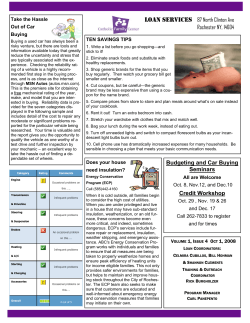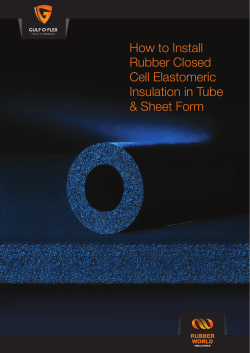
Pittsburgh Corning Europe (Branch Middle East) DAFZA, P.O.Box: 54823 Dubai, United Arab Emirates
Pittsburgh Corning Europe (Branch Middle East) DAFZA, P.O.Box: 54823 Dubai, United Arab Emirates Tel: +9714.7017.522 Fax: +9714.7017.523 info@foamglas.ae www.foamglas.ae Why FOAMGLAS insulation in a ventilated façade or behind stone cladding? Marco Vincenz, Nov. 2009 When heavy material such as natural stone or decorative concrete is used as a cladding, one key criterion is the durability of the wall. The insulation material must also have the same long service life. The replacement of the insulation will be a costly exercise. With its extremely long service life and references more than 50 years old, FOAMGLAS insulation is the best choice. FOAMGLAS applied with adhesive on structure stone cladding with single anchor FOAMGLAS mechanical fixed on structure stone cladding on rail system Resistant to moisture and constant thermal conductivity Foamglas cellular glass is totally impervious to water and cannot be damaged by rainwater seeping behind the cladding or the influence of water vapour or high humidity. With millions of hermetic closed cells, Foamglas is totally impervious to any kind of moisture. This physical property is unique and means there is no need for any covering of the insulation to protect from high humidity in the Middle East. No vapour barrier is required! In case other insulation material is used like mineral wool, a vapour barrier is required to protect the insulation from the water vapour. This is done with an aluminium foil lamination on the insulation. This foil should be applied in perfect condition without damages and proper sealed joints to avoid humid air to reach structure and condensate. Moisture has a dramatic effect on lambda values. Many studies have been carried out on the effects on thermal conductivity of volume related moisture content. A moisture content of 1% by volume on mineral fibre insulation reduces the performance to 30%! 1|P a g e Pittsburgh Corning Europe (Branch Middle East) DAFZA, P.O.Box: 54823 Dubai, United Arab Emirates Tel: +9714.7017.522 Fax: +9714.7017.523 info@foamglas.ae www.foamglas.ae Mineral wool insulation with aluminium vapour barrier, penetrations must be taped Open joints will lead to a wet insulation because of condensation FOAMGLAS - No vapour barrier required Fire protection – safe against fire and no fume development For fire protection in ventilated cladding systems with several levels or even in high rise buildings, the need of a non-combustible insulation material is obvious. The chimney effect created by the ventilation space means that the fire will spread quickly. Although plastic foam insulation are described as “fire-safe”, they are combustible as well as creating significant fumes and toxic smoke, hence it follow they are unsuitable. Mineral fibre products provide the required levels often of non-combustibility as long as they are not aluminium-laminated. Due to the level of resins used to bind the fibres and add the lamination in their manufacture, they can contribute towards fire. Foamglas is classified as non-combustible and no contribution to fire. (Euro Class A1, like concrete) With ASTM fire index Zero for smoke development and Zero for surface burning, Foamglas provides unrivalled fire protection to the building. High rise building with plastic foam insulation supporting fire / toxic fume! Many international regulations prohibits plastic foams in facades!!! 2|P a g e Fire in Dubai supported by plastic insulation Pittsburgh Corning Europe (Branch Middle East) DAFZA, P.O.Box: 54823 Dubai, United Arab Emirates Tel: +9714.7017.522 Fax: +9714.7017.523 info@foamglas.ae www.foamglas.ae Stability and design advantage Deformation-free FOAMGLAS is dimensional stable and therefore very easy to fix. No sinking, no swelling because of humidity! FOAMGLAS enables an easy build up and keeps the details very easy. Around columns the rigidity will help to insulate proper. Open joint will not show shiny or collared insulation material. Last but not least, the supervision and acceptance of the application of FOAMGLAS can be done properly. The cladding doesn’t have to be done immediately and therefore will guarantee the perfect thermal protection for decades. Joints with mineral wool insulation and aluminium lamination trough open joint the insulation behind the cladding will be visible Joints with black FOAMGLAS behind What about ecology and economy? What is more sustainable than an ecological product with a very long lifespan? FOAMGLAS can look back to more than 50 years of experience. FOAMGLAS is produced from less energy compared to others, contains 66% recycling glass, doesn’t use water for the production and is certified with many green certificates like ecospecifier, green spec and “Environmental Product Declaration”. Using FOAMGLAS will also support the LEED rating with credits. Next to the initial cost the durability and failure risk are deciding factors. Cost analyses are showing that 60 to 70% of the total lifecycle costs for building are after the building process. Therefore the efficient build up in a high quality which guarantees the constant thermal performance over decades is a must. A lot of money is wasted for maintenance, refurbishments, cost of scaffolding, demolition, removal and disposal of used materials, interim storage and the new build up. It cause enormous and stress for all involved. FOAMGLAS is the lifetime solution! 3|P a g e
© Copyright 2025





















